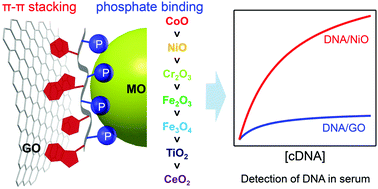当前位置:
X-MOL 学术
›
Mater. Horiz.
›
论文详情
Our official English website, www.x-mol.net, welcomes your feedback! (Note: you will need to create a separate account there.)
Janus DNA orthogonal adsorption of graphene oxide and metal oxide nanoparticles enabling stable sensing in serum†
Materials Horizons ( IF 13.3 ) Pub Date : 2017-10-27 00:00:00 , DOI: 10.1039/c7mh00804j Biwu Liu 1, 2, 3 , Lingzi Ma 1, 2, 3 , Zhicheng Huang 1, 2, 3 , Hao Hu 4, 5, 6 , Peng Wu 4, 5, 6 , Juewen Liu 1, 2, 3
Materials Horizons ( IF 13.3 ) Pub Date : 2017-10-27 00:00:00 , DOI: 10.1039/c7mh00804j Biwu Liu 1, 2, 3 , Lingzi Ma 1, 2, 3 , Zhicheng Huang 1, 2, 3 , Hao Hu 4, 5, 6 , Peng Wu 4, 5, 6 , Juewen Liu 1, 2, 3
Affiliation

|
While DNA/graphene oxide (GO) conjugates have been widely used for DNA detection, they suffer from non-specific DNA displacement by proteins, making their application in biological samples difficult. To find new materials tightly adsorbing DNA but not proteins, we screened seven metal oxide nanoparticles, all interacting with the phosphate backbone of DNA, while DNA uses its nucleobases to interact with GO. In this regard, DNA is a Janus polymer orthogonally adsorbing GO and metal oxides. The DNA adsorption affinity ranks CoO > NiO > Cr2O3 > Fe2O3 > Fe3O4 > TiO2 > CeO2 based on a phosphate displacement assay. Among them, CoO is nearly fully resistant to protein displacement, while NiO has the best limit of detection of 0.24 nM DNA. This study provides fundamental insights into the biointerface chemistry of DNA, and reveals new materials useful for bioanalytical chemistry, DNA separation, and DNA-directed assembly.
中文翻译:

Janus DNA正交吸附氧化石墨烯和金属氧化物纳米颗粒,可在血清中稳定感应†
尽管DNA /氧化石墨烯(GO)共轭物已被广泛用于DNA检测,但它们遭受蛋白质的非特异性DNA置换,使其难以应用于生物样品中。为了找到能紧紧地吸附DNA但不能紧紧吸附蛋白质的新材料,我们筛选了七个金属氧化物纳米颗粒,它们均与DNA的磷酸骨架相互作用,而DNA使用其核碱基与GO相互作用。在这方面,DNA是正交吸附GO和金属氧化物的Janus聚合物。DNA吸附亲和力依次为CoO> NiO> Cr 2 O 3 > Fe 2 O 3 > Fe 3 O 4 > TiO 2 > CeO 2基于磷酸盐置换试验。其中,CoO几乎完全抵抗蛋白质置换,而NiO具有0.24 nM DNA的最佳检测极限。这项研究提供了对DNA生物界面化学的基本见解,并揭示了可用于生物分析化学,DNA分离和DNA定向组装的新材料。
更新日期:2017-10-27
中文翻译:

Janus DNA正交吸附氧化石墨烯和金属氧化物纳米颗粒,可在血清中稳定感应†
尽管DNA /氧化石墨烯(GO)共轭物已被广泛用于DNA检测,但它们遭受蛋白质的非特异性DNA置换,使其难以应用于生物样品中。为了找到能紧紧地吸附DNA但不能紧紧吸附蛋白质的新材料,我们筛选了七个金属氧化物纳米颗粒,它们均与DNA的磷酸骨架相互作用,而DNA使用其核碱基与GO相互作用。在这方面,DNA是正交吸附GO和金属氧化物的Janus聚合物。DNA吸附亲和力依次为CoO> NiO> Cr 2 O 3 > Fe 2 O 3 > Fe 3 O 4 > TiO 2 > CeO 2基于磷酸盐置换试验。其中,CoO几乎完全抵抗蛋白质置换,而NiO具有0.24 nM DNA的最佳检测极限。这项研究提供了对DNA生物界面化学的基本见解,并揭示了可用于生物分析化学,DNA分离和DNA定向组装的新材料。



























 京公网安备 11010802027423号
京公网安备 11010802027423号